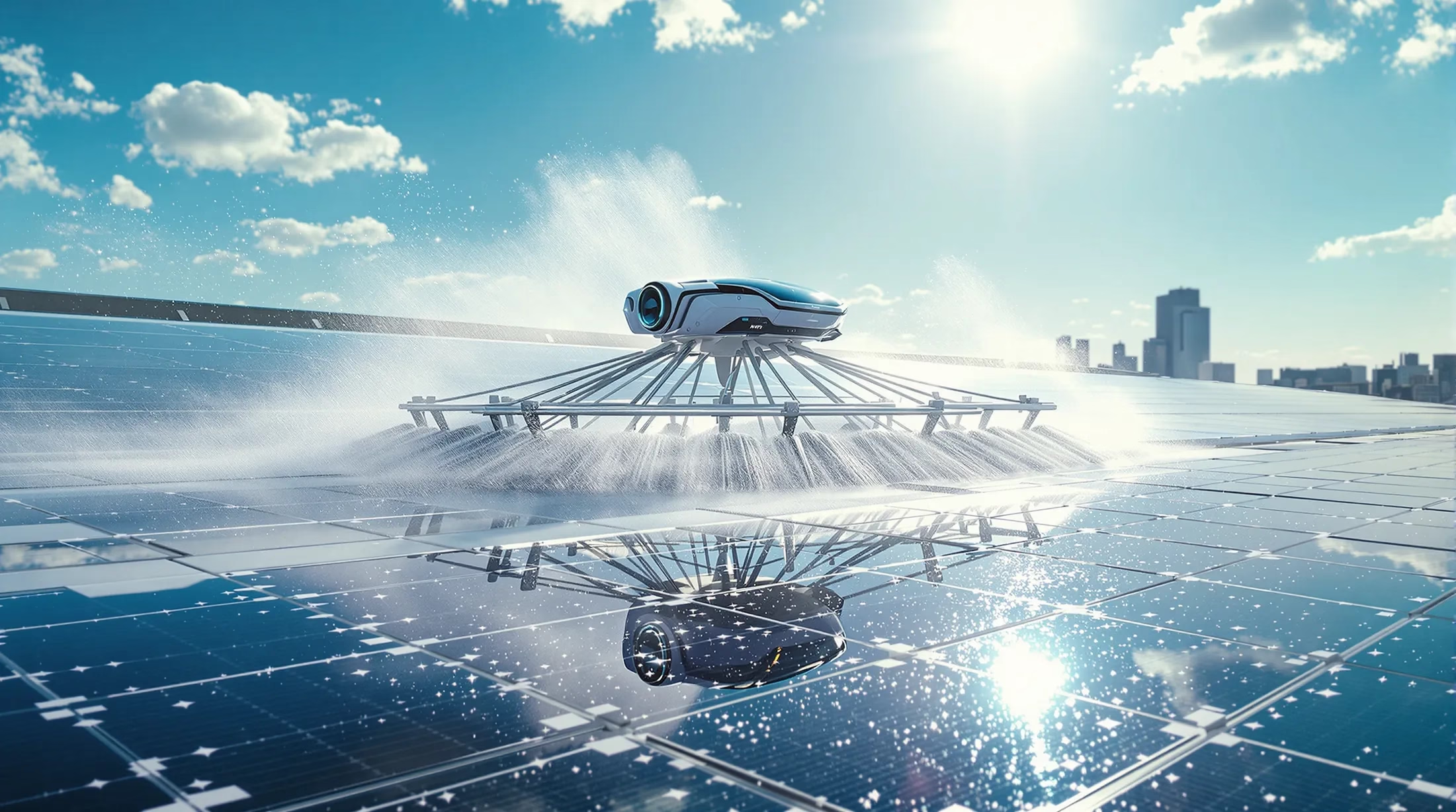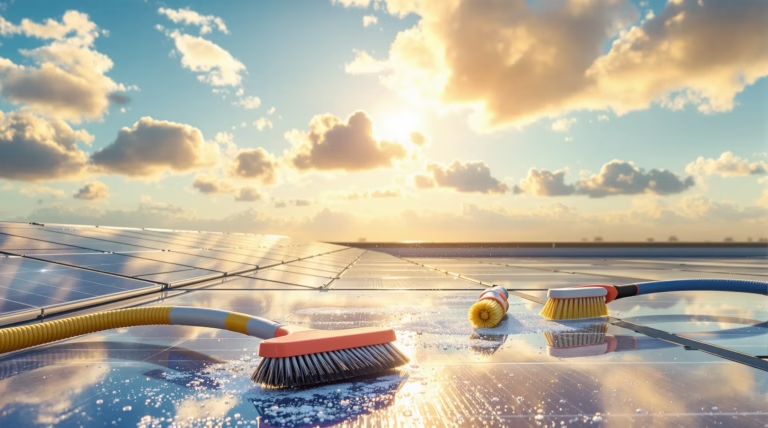How to Clean Solar Panels on Roof Automatically: A Complete Guide
Maximize your solar investment’s potential with automated cleaning solutions that keep your panels operating at peak efficiency. Learn how these innovative systems can protect and enhance your renewable energy system while eliminating the need for manual maintenance.
Understanding the Importance of Cleaning Solar Panels
Solar panels represent a significant investment in sustainable energy, but their efficiency relies heavily on proper maintenance. When sunlight hits clean solar panels, they convert that energy into electricity at maximum capacity. However, as panels accumulate dust, dirt, pollen, bird droppings, and other debris, their ability to absorb sunlight diminishes considerably.
Research shows that dirty solar panels can experience efficiency losses ranging from 7% annually in parts of the United States to a staggering 50% in dusty regions like the Middle East. This reduction in performance directly impacts your energy production and, consequently, your return on investment. Regular cleaning ensures your solar system operates at peak efficiency, maximizing both energy generation and financial benefits over the system’s lifetime.
Why Clean Solar Panels Regularly?
- Maintains optimal energy production by ensuring maximum sunlight absorption
- Prevents damage from corrosive substances like bird droppings
- Preserves warranty validity by meeting manufacturer maintenance requirements
- Extends system lifespan through consistent care
- Particularly crucial for horizontal panels where natural rainfall cleaning is ineffective
Impact of Dirt and Debris on Solar Panel Performance
The accumulation of dirt and debris on solar panels creates what industry professionals call ‘soiling’—a significant factor in reduced energy output. Even a thin layer of dust can block sunlight from reaching the photovoltaic cells, immediately decreasing electricity production. Studies reveal that soiling can reduce panel efficiency by up to 25% in just one month without rainfall in particularly dusty environments.
| Debris Type | Impact |
|---|---|
| Dust | Uniform reduction in efficiency across panel surface |
| Bird droppings | Creates hot spots and potential long-term damage |
| Fallen leaves | Causes inconsistent sunlight absorption and overheating |
Introduction to Automatic Solar Panel Cleaning Systems
As solar installations become increasingly popular, maintaining their efficiency through regular cleaning has evolved beyond manual methods. Automatic solar panel cleaning systems represent the cutting edge of solar maintenance technology, offering hands-free solutions that ensure consistent performance without the risks associated with rooftop access.
How Automatic Cleaning Systems Work
- Utilizes programmed routines or sensor-triggered activation
- Employs robotic devices with specialized tracks or rails
- Features soft microfiber cloths or brushes for safe cleaning
- Often operates without water using advanced air-flow technology
- Includes self-cleaning capabilities for system components
Types of Automatic Cleaning Systems
| System Type | Features | Best For |
|---|---|---|
| Robotic Cleaners | Autonomous navigation, microfiber technology | Large commercial installations |
| Sprinkler Systems | Timed water sprays, weather-based programming | Areas without water restrictions |
| Electrostatic Systems | Electrical charge-based dust repulsion | Environments with fine dust particles |
Benefits of Using Automatic Cleaning Systems for Roof Solar Panels
Automatic cleaning systems for roof-mounted solar panels revolutionize maintenance by eliminating manual cleaning challenges. These innovative solutions employ robotic brushes, sprinklers, or electrostatic technology to maintain panels at peak performance levels. While initial investments range from $400 to $1,200, these systems help maintain up to 95% efficiency in solar installations, particularly valuable in dusty or high-pollution environments.
- Eliminates safety risks associated with roof access
- Removes need for personal protective equipment like harnesses
- Provides essential maintenance for hard-to-reach installations
- Ensures consistent performance without human intervention
- Operates independently on steeply pitched roofs
Increased Efficiency and Energy Output
| Environmental Condition | Efficiency Impact |
|---|---|
| Typical environments | 7-25% annual reduction without cleaning |
| Dusty regions | Up to 50% reduction without cleaning |
| With automatic cleaning | Up to 15% more electricity annually |
Automated systems excel at removing challenging contaminants that manual cleaning might miss, particularly fine particulate matter. Using advanced microfiber technology, these systems ensure thorough cleaning that translates directly to increased energy output and faster return on investment, especially in arid or polluted environments.
Cost-Effectiveness and Long-Term Savings
- Eliminates professional cleaning fees ($150-$350 per session)
- Investment recovery period of 2-4 years
- Reduces panel surface wear through gentle cleaning
- Maintains warranty coverage requirements
- Provides continuous returns throughout system lifetime
Choosing the Right Automatic Cleaning System for Your Roof
The market offers three primary automatic cleaning solutions, each with unique advantages based on your specific installation needs:
| System Type | Best Suited For |
|---|---|
| Robotic cleaners | Autonomous panel surface navigation |
| Sprinkler systems | Targeted water jet cleaning |
| Electrostatic systems | Dust particle repulsion through electrical charges |
Factors to Consider When Selecting a System
- Roof pitch and panel configuration
- Local climate conditions and water availability
- Installation complexity and professional requirements
- Operating costs and maintenance needs
- Panel brand compatibility and mounting systems
- Budget constraints and long-term value
Top Automatic Cleaning Systems on the Market
Ecoppia’s E4 system leads the robotic cleaning technology market with its innovative microfiber cloth and controlled airflow technology, eliminating water consumption. This solution excels in large-scale installations within arid environments, featuring solar-powered charging and dedicated rail operation. For home installations, Washpanel offers compact robotic solutions capable of navigating both framed and frameless panels, automatically adjusting pressure based on detected debris.
| System | Key Features | Warranty Period |
|---|---|---|
| Ecoppia E4 | Waterless operation, solar-powered charging | 2-5 years |
| Washpanel | Adaptive pressure control, universal compatibility | 2-5 years |
| SunBrush | Smart weather integration, calibrated water pressure | 2-5 years |
| SolarSkin | Electrostatic dust repulsion, preventative protection | 2-5 years |
Installation and Maintenance of Automatic Cleaning Systems
Professional installation is essential for automatic solar panel cleaning systems to ensure optimal performance and protect your investment. The installation requirements vary by system type, from robotic cleaners needing mounting tracks to sprinkler systems requiring water connections and electrostatic systems with specialized electrical components.
- Regular system inspections required
- Component replacement schedules vary by model
- Software updates ensure optimal performance
- Seasonal maintenance adjustments necessary
- Professional installation recommended for warranty coverage
Installation Process Overview
The installation begins with a comprehensive site assessment to determine the optimal system configuration based on roof type, panel layout, and local climate conditions. For robotic systems, technicians install precisely aligned tracks or rails to enable safe cleaning unit movement. Sprinkler-based systems require careful integration of waterlines, weather-resistant wiring, and strategically positioned spray heads.
- Site assessment and system configuration planning
- Track or rail installation for robotic systems
- Waterline and electrical connections setup
- Smart controller integration and programming
- System testing and performance verification
Routine Maintenance Tips
Effective maintenance starts with regular visual inspections of critical components for wear or debris accumulation. For robotic systems, quarterly track inspections ensure secure attachment and clear pathways. Brush or microfiber element replacements typically occur every 1-2 years, depending on usage patterns and environmental conditions.
- Quarterly inspection of tracks and rails
- Bi-annual brush or microfiber element checks
- Seasonal nozzle and filter maintenance
- Regular software updates and diagnostics
- Performance monitoring through system output data
- Winter preparation for water-based systems







